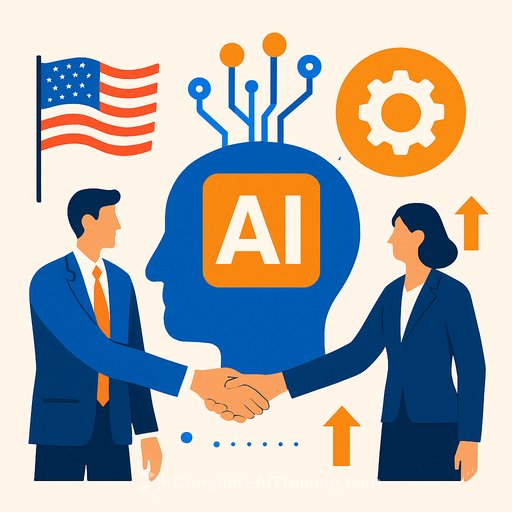How the U.S. Can Win the Global AI Race
AI leadership isn't a partisan slogan. It's a national capability decision. New York and Florida are proving a simple point: states can move faster than federal timelines and build the conditions researchers need to ship breakthroughs.
Winning means more than headlines about one model beating another. It means sustained capacity: talent, compute, data, safety, and deployment working as one system.
What "winning" actually looks like
- Security: trustworthy AI for defense, biosecurity screening, and critical infrastructure operations.
- Productivity: measurable gains across labs, factories, clinics, and classrooms-backed by audit trails and benchmarks.
- Science lift: faster hypothesis cycles, automated literature synthesis, and simulation support across physics, bio, materials, and energy.
- Standards and safety: U.S.-led evaluation, incident reporting, and testbeds adopted globally.
Build the public AI stack
Researchers need predictable access to compute, high-quality data, and safe deployment channels. Treat AI like core infrastructure, not a one-off grant.
- Compute: State-backed GPU clusters with federal matching, low-carbon power, and fair scheduling for universities, startups, and agencies. Publish SLAs and utilization dashboards.
- Data: Create domain-specific data trusts with clear licensing, lineage, consent, and retention. Fund data stewards as a first-class role.
- Models: Support both open and closed models with contracts that guarantee research access, eval rights, and safety tooling.
- Access: Expand shared facilities modeled on the NAIRR concept and formalize inter-state reciprocity for researchers.
Standards, evaluation, and safety
We need repeatable testing, not vibes. Bake red teaming, interpretability probes, and bio/chem misuse screens into every major release. Require incident reporting and model cards for publicly funded work.
Anchor programs on recognized frameworks and independent audits. The NIST AI Risk Management Framework is a solid baseline-use it for grant conditions and procurement.
Semiconductors and supply chain
No chips, no progress. Fully fund advanced packaging, photonics, and workforce development alongside fabs. Tie incentives to open standards for chiplets and interconnects, plus secure tooling and verified firmware.
Track onshore capacity, not just announcements. The CHIPS Program Office offers the policy backbone here: CHIPS.gov.
Talent and immigration that actually works
- Visa speed lanes: Fast-track STEM PhDs and experienced engineers; clear backlogs; grant state research centers sponsor status.
- Fellowships: Multi-year, portable funding tied to open science deliverables and safety training.
- K-14 to industry: Modernize CS, data, and ethics curricula; fund community college programs aligned with semiconductor and MLOps roles.
- Cross-over residencies: Incentivize industry-to-lab and lab-to-agency rotations for knowledge transfer.
State playbook: New York and Florida as signals
State action cuts through the noise. A practical template looks like this:
- Cluster grants: Co-locate compute, lab space, and pilot sites near universities and hospitals. Offer predictable, multi-year support.
- Public testbeds: Open evaluation environments for health, finance, manufacturing, and climate-plus clear pathways to procurement.
- SMB vouchers: Give smaller firms compute credits, advisory hours, and security reviews to ship their first deployments.
- Data partnerships: Broker legal and ethical data access with agencies and institutions; fund de-identification and governance.
Open science with secure collaboration
Open by default, secure by design. Fund differential privacy, secure enclaves, MPC, and synthetic data validation. Require dataset documentation, versioning, and revocation plans.
Set shared repositories for benchmarks and eval traces so results can be replicated across labs. Make this a grant requirement.
Defense and societal-scale deployments
- Acquisition reform: Outcome-based contracts, milestone prizes, and on-ramps for labs and startups.
- T&E ranges: Safety-critical testing for autonomy, comms, logistics, and biosecurity screens with real-world constraints.
- Interoperability: Common APIs and data formats across agencies to avoid vendor lock-in.
What labs and universities can do now
- Adopt a formal evaluation stack: threat models, audits, incident reporting, and reproducibility checklists.
- Stand up MLOps baselines: data lineage, model registry, rollbacks, and human-in-the-loop reviews.
- Create compute exchanges across campuses and states to smooth peak demand.
- Publish negative results and red-team findings to raise the floor for everyone.
Scorecard: measure progress, not press releases
- Share of global training FLOPs and domestic inference capacity available to researchers.
- Benchmark leadership across public eval suites (capability, safety, and reliability).
- Time-to-deploy for funded projects into real environments with compliance cleared.
- Open-source participation: datasets, eval tools, and model improvements adopted at scale.
- Semiconductor milestones: packaging throughput, photonics pilots, yield, and workforce placement.
Funding that aligns incentives
Shift from one-off grants to programs that reward shipped, tested systems. Use ARPA-style portfolios, SBIR matching for compute and audits, and outcome-based procurement tied to verified evals.
Bottom line
The U.S. wins by building common infrastructure, setting clear standards, and giving researchers the tools to move fast and safely. States have momentum. Federal programs can provide scale. Make the system boring, reliable, and open-and the breakthroughs follow.
If your team needs a quick way to map skills to roles and find practical courses, see Complete AI Training: courses by job.
Your membership also unlocks:






